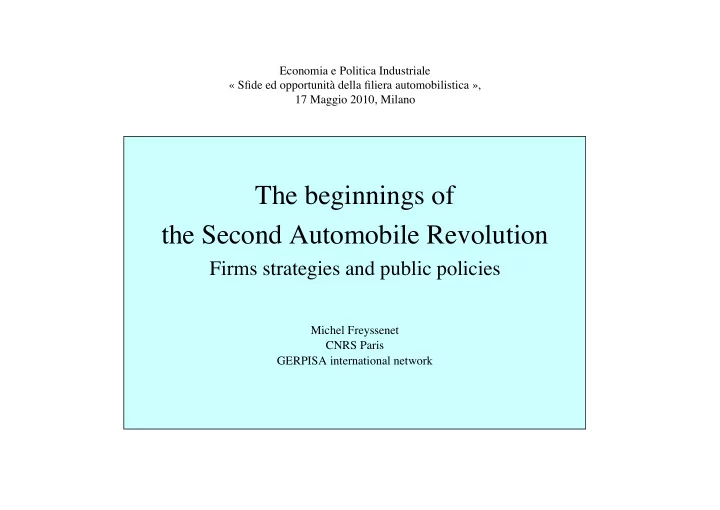

Economia e Politica Industriale « Sfide ed opportunità della filiera automobilistica », 17 Maggio 2010, Milano The beginnings of the Second Automobile Revolution Firms strategies and public policies Michel Freyssenet CNRS Paris GERPISA international network
The last GERPISA book is intitled…
Four stages and conditions for a revolution in transport system • The crisis of the previous transport system • The emergence of various solutions, combining and adaptating innovations often coming from others sectors • The formation of a coalition of forces for one of the solutions, despite its great uncertainties • Macroeconomic decisions and public policies allowing the diffusion and the generalization of adopted solution
Oil and gas stocks by world resident
Comparison with the beginning of automobile • The horse-drawn was becoming more an more an obstacle to the mobility and the productivity in the new rural, industrial, urban and military context at the end of the XIXth century. Many people protested and wished to find other solutions • New innovative products in other fields: electricity, benzine, petrol, little motors for family workshops, bicycles, etc. • Some technicians, independant or salaried ones, imagined possible combinations of these innovations and proposed engines for vehicles: powered by steam, electricity or petrol • Some capitalist entrepreneurs perceived the possible solvent demand, immediately and for the future, and adapted technicians prototypes in complete vehicles for buyers: upper-class, taxi, shopkeepers, transport contractors, army, etc.
The most known « clean(er) automobile » start-ups in some countries Start-up suppliers newcomers others USA Tesla, Zap, Fisker, Miles Electric, GEM Think, Phoenix France Venturi, Biro Bolloré, SVE Heuliez, FAM, Aixam Dassault, Michelin Germany E-Wolf, Ruf Italy Micro-Vett Tazzari, Maranello, Pininfarina Suisse Protoscar, Rinspeed UK Stevens Vehicles, Lightning, Nice car Suède Koenigsegg Japan SIM-DRIVE India Reva Tata China BYD, Geely
The electric vehicle « La Jamais-Contente » first automobile to break the 100km/h barrier: 1899
The choice of petrol engined car: an incredible paradox • Why the carmakers choiced the more uncertain solution ? • Many contradictory and historically wrong explanations • The probable reason: the petrol was the only energy easely transportable, stockable and distribuable in all territories and in all countries. A complete system of delivery was setting up rapidly. The distribution of petrol wasn’t a monopol • If that is true, the technic, industrial, price constraints as obstacles to new types of cars must be relativised
« well to wheel » CO2 emission, according to the types of motor and of energy
Five (changing!) strategies: priority to… less carbon Hybrid all types plug-in hybrid full electric fuels and full electric Fiat Toyota Ford GM Renault Honda PSA Mitsubishi Nissan Mazda Volkswagen BYD Geely Hyundaï Volvo Porsche Chrysler
Partnerships to create the market
alternative energies national preference for clean(er) cars …until now… Agro-fuel Natural gas Plug-in objectives of hybrid, full reduction, electric only Brazil Russia USA Japan Italy China Germany France European Union Great Britain
The full electric vehicle could be the vehicle of the Second Automobile Revolution • Only a complete change could allow a relaunch of profit and of competition • The electric vehicle isn’t only a new engine, but a complete new automobile architecture, a new product and a new knowledge • The electricity is now accessible in all territories and almost in all countries and it is frequently much less expensive than the petrol. • The technical problems of electric vehicle are much less important than the problems of the petrol automobile at its appearence • The best opportunity for newcomers, especially Chinese newcomers • A new profit strategy? « innovation and volume »?
in short…. • The political will to fight against the climate warming up is uncertain • But not the tendencial increase of the real petrol price, because of the exponential needs of BRIC • So the « automobilisation » of BRIC can pursue durably only with alternative energies and new types of automobiles • This constraint and the full electric car are great opportunities for Chinese carmakers to become economically and technologically independant from the historical carmakers • The only uncertainty is not the future growth of BRIC, but the insufficient distribution of national revenue to the people of these countries
For more informations and analysis http://freyssenet.com http://gerpisa.univ-evry.fr http://leblog.gerpisa.org
Recommend
More recommend